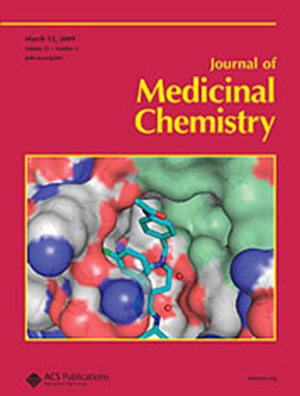Discovery of a Novel MNK Inhibitor (NSP-1047) with In Vivo Anti-acute Myeloid Leukemia Activity.
IF 6.8
1区 医学
Q1 CHEMISTRY, MEDICINAL
引用次数: 0
Abstract
MAPK-interacting kinases (MNKs) phosphorylate the eukaryotic initiation factor 4E (eIF4E), critical for cap-dependent translation. The MNK/eIF4E pathway plays a role in the development and progression of various hematological and solid tumors. Here, we report the discovery of a novel polycyclic compound 21e (NSP-1047), which inhibits MNK1 and MNK2 with high potency, leading to a reduction in the phosphorylation of eIF4E. NSP-1047 shows strong in vitro antiproliferative activity against multiple acute myeloid leukemia (AML) cell lines. Meanwhile, it enhances anticancer immune responses by downregulating the expression of immune checkpoint proteins and suppressing the secretion of inflammatory cytokines. NSP-1047 displays excellent ADME and pharmacokinetic properties, and encouraging safety profiles, with a highest nonsevere toxic dose (HNSTD) of 750 and 200 mg/kg for SD rats and Beagle dogs, respectively. In vivo efficacy evaluation in AML xenografts demonstrates significant tumor suppression, with tumor regression observed at tolerated doses, both as monotherapy and in combination with Ara-C or venetoclax.具有体内抗急性髓系白血病活性的新型MNK抑制剂(NSP-1047)的发现。
mapk相互作用激酶(MNKs)磷酸化真核起始因子4E (eIF4E),这对帽依赖翻译至关重要。MNK/eIF4E通路在多种血液学和实体肿瘤的发生发展中发挥作用。在这里,我们报告了一种新的多环化合物21e (NSP-1047)的发现,它能高效抑制MNK1和MNK2,导致eIF4E磷酸化的降低。NSP-1047对多种急性髓性白血病(AML)细胞系显示出较强的体外抗增殖活性。同时,它通过下调免疫检查点蛋白的表达和抑制炎症细胞因子的分泌来增强抗癌免疫应答。NSP-1047对SD大鼠和Beagle犬的最高非严重毒性剂量(HNSTD)分别为750 mg/kg和200 mg/kg,具有良好的ADME和药代动力学特性,且安全性良好。AML异种移植物的体内疗效评估显示出显著的肿瘤抑制作用,在耐受剂量下,无论是单药治疗还是与Ara-C或venetoclax联合治疗,都能观察到肿瘤消退。
本文章由计算机程序翻译,如有差异,请以英文原文为准。
求助全文
约1分钟内获得全文
求助全文
来源期刊

Journal of Medicinal Chemistry
医学-医药化学
CiteScore
4.00
自引率
11.00%
发文量
804
审稿时长
1.9 months
期刊介绍:
The Journal of Medicinal Chemistry is a prestigious biweekly peer-reviewed publication that focuses on the multifaceted field of medicinal chemistry. Since its inception in 1959 as the Journal of Medicinal and Pharmaceutical Chemistry, it has evolved to become a cornerstone in the dissemination of research findings related to the design, synthesis, and development of therapeutic agents.
The Journal of Medicinal Chemistry is recognized for its significant impact in the scientific community, as evidenced by its 2022 impact factor of 7.3. This metric reflects the journal's influence and the importance of its content in shaping the future of drug discovery and development. The journal serves as a vital resource for chemists, pharmacologists, and other researchers interested in the molecular mechanisms of drug action and the optimization of therapeutic compounds.
 求助内容:
求助内容: 应助结果提醒方式:
应助结果提醒方式:


